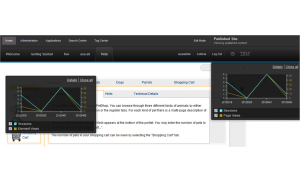Thomas Stober, IBM Lead Architect WebSphere Portal Foundation, gave a presentation at IBM Connect 2013 titled “Enhance WebSphere Portal Delivery with Real time Active Analytics Insights”. Of course, site analytics tracks user interaction with your site and can be a key input to help you optimize your portal design. It also can play an important role in personalization of the site for each user by tracking what they do on the site.
WebSphere Portal Active Site Analytics (ASA) framework is used to integrate third party analytics tools which analyze web site visitor demographics and interaction patterns. ASA is built-in to WebSphere Portal, making it easy for you to integrate one of the many analytic tools into the overall experience.
Portal does not provide the analytics engine – that is provided by systems such as CoreMetrics, WebTrends, Unica and Adobe SiteCatalyst. Portal ships with tag aggregators for CoreMetrics and Unica. It also includes a generic aggregator that can be updated easily for other vendors. These aggregators pull the analytic data from the page and sends it to one of the analytic systems. You can add your own tags to a page to provide even more insights into the user behavior.
The analytics systems are used to generate reports and analysis that marketers and business users can review. To make it very easy to view the analytics reports and charts, Portal provides a mechanism to view those reports directly on the page and in context of the various items on the page. So you can go to a specific content area on the page and directly view the analytics report/chart for that content. This is shown in the picture below.
Thomas showed several IBM Digital Marketing Optimization solution examples and also covered how to use ASA to:
- integrate third party web analytics aggregator scripts to web portal and content pages
- collect real-time data for analysis
- out-of-box reporting
- campaign management options
New in WebSphere Portal 8 are even better inline marketing overlays, which provide business and marketing people direct, real-time views of sub-page level data, including portlets, and content items. These overlays make it easy to see user behavior for analysis and then use this information to drive results.
The important point for us is that site analytics is no longer just reports on how many people hit our site and what pages were viewed most. Active Site Analytics has now evolved into accessing real-time insights into the usage patterns of your Web Experience platform. Once you capture usage data you can then optimize delivery of your marketing messages to your audiences through multiple channels, enhanced by high capability campaign management systems, such as the IBM Marketing Center.
